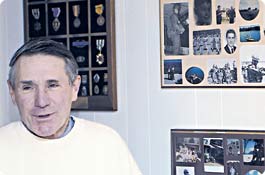Blood flowing from the bullet holes in his left shoulder and armpit, U.S. Army Captain Robert H. Edwards ’60 was five years and millions of miles from Lafayette when battling a crack division of North Vietnamese regulars in the Ia Drang Valley in 1965.
The 27-year-old commander of Charlie Company of the 1st Battalion, 7th Cavalry Regiment was pinned down by machine-gun fire in a bunker with dead and wounded infantrymen under his command.
In an action his commander would later call “heroic,” Edwards used his free hand to operate a radio and call in A1 Skyhawk fighter planes and helicopter gunships to attack the 2,000 enemy troops that surrounded 450 Americans in Landing Zone X-Ray in the Central Highlands.
“I radioed the battalion commander to arrange for fire and air support,” recalls Edwards, 63, now retired, living near New Hope, Pa. The battalion commander was Col. Harold G. Moore, who three decades later would write a best-selling account of the battle with journalist Joseph L. Galloway, We Were Soldiers Once…And Young (1992). The book was made into the hit Paramount movie, We Were Soldiers, released in March with Mel Gibson starring as Moore.
Fought on Nov. 14-16, 1965, Ia Drang is considered the first major battle of the Vietnam War. Though 234 Americans lost their lives, the close encounter shaped America’s course of action in the 10-year conflict that divided the nation like no other war fought on foreign soil.
Moore, 80, who spent 10 years researching the book, recounted Edwards’ actions in the opening sentences. Edwards’ command post, Moore wrote, was a “small bloody hole in the ground” crowded with men, dead and dying.
23-Year Military Career
Edwards received a government and law degree and reported for duty at Ft. Indiantown Gap the day after commencement in 1960. He was commissioned as a second lieutenant in Lafayette’s ROTC. He had come from The Hun School of Princeton, where he was a member of the rowing team. Lafayette didn’t offer rowing so he played varsity lacrosse. He also served as president and social chairman of Phi Delta Theta fraternity.
“Lafayette did a great job of preparing me for what I ended up doing,” Edwards says. The government and law curriculum taught him to think and write. He learned aggressiveness and teamwork on the lacrosse field. ROTC taught him the Army way of doing things. And, yes, he credits his fraternity brothers with honing his leadership skills. “Leading your peers is probably the toughest thing to do,” Edwards says, reflectively. “If you can handle two fraternity brothers at 2 a.m., you’re a leader.”
Edwards was assigned to Ft. Benning, Ga., and would return there time and again during a 23-year military career. He attended Infantry Officer’s School and Airborne School and spent a tour of duty in Germany before returning to Ft. Benning in November 1963.
Edwards was promoted to company commander in April 1964 when his unit was assigned to the 11th Air Assault [Test] Division. The use of helicopters in combat was a relatively new concept, and Edwards’ unit was on the cutting edge of a strategy that would come to symbolize the war in Southeast Asia. Edwards still remembers President Lyndon B. Johnson ordering his unit, renamed the 1st Cavalry Division [Airmobile], to Vietnam in a televised speech on July 28, 1965. His unit was surprised, several months later during hand-to-hand combat in South Vietnam, by the size and professionalism of Gen. Chu Huy Man’s North Vietnamese troops.
“We were out looking for a fight, and we found one in greater numbers than expected,” Edwards says. “These were no rag-tag farmers by day, guerillas by night. These were good, disciplined soldiers. They had to be to continue to attack despite the firepower we brought against them.”
The movie, Edwards says, does a good job telling the story of Vietnam from the soldier and family viewpoint. But being Hollywood, he says, it added “a little more spice” than the actual events. Edwards is portrayed by Dylan Walsh.
After several months recuperating from his wounds in Valley Forge military hospital, Edwards went back to Ft. Benning. He taught military science at Ohio State and returned in 1968 for a second tour of duty in Vietnam.
He would never again see the level of combat he experienced in that historic battle in 1965. “We had trained together for a year and a half before going to Vietnam,” says Edwards. “There had been a great deal of bonding, cohesion, and continuity.”
The military learned a lot of lessons in Vietnam, Edwards says, that are apparent in the current action in Afghanistan. “One important aspect is that our civilian leaders make a determined effort to rally the country behind the cause,” he says. “Today, the American people are supportive of the troops. In Vietnam, the people didn’t understand why we were there.”
Edwards retired as a colonel in August 1983. Among the many military decorations he received were two medals for the Ia Drang battle—The Silver Star and a Purple Heart. His division received the Presidential Unit Citation. After working in Georgia, he moved to Bucks County and worked for eight years as assistant borough manager in Dublin. He revived his interest in rowing and competes in a senior division with the Swan Creek Rowing Club in Lambertville, N.J.
The Lafayette tradition continued in the Edwards family. Robert Edwards ’85, a history graduate, is a documentary filmmaker in New York. Attending Lafayette on an ROTC scholarship, he spent seven years in the Army and participated in the Persian Gulf War with the 82nd Airborne. Douglas Edwards ’95 works for Adobe Systems in San Jose, Calif.

Captain Robert H. Edwards '60
